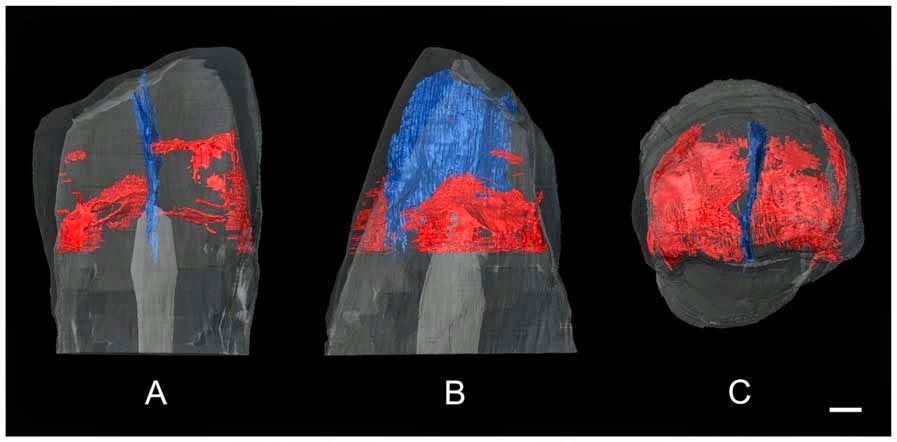Biological organisms often produce a variety of mineralized tissues,
such as bones, teeth and shells. In addition to those usually produce,
individual organisms often produce other biomineralized tissues pathologically,
that is due to disease or environmental stress. In human beings such tissues
can include gallstones, bladder stones, dental calculus (plaque) or calcified
tumours as well as other tissues becoming calcified or ossified.
In a paper published in the journal PLoS One on 2 October 2014,
Judyta Gładykowska-Rzeczycka of Gdańsk in Poland and Dariusz Nowakowski of the
Department of Anthropology at the Wrocław University of Environmental and LifeSciences describe a pathological ‘stone’ from a medieval burial in Gdansk,
Poland.
The site of the burial lies within a graveyard used from the 10th
century until 1813, but built over by a church, a monastery and the Market Hall
of Gdańsk Old Town. Many of the bodies at the site have been dug up then
reburied, resulting in widespread damage to remains, as well as disarticulation
and mixing of skeletons. Despite this the site has yielded about 1000 burials,
and is under ongoing investigation by the Gdańsk Archaeological Museum.
The stone was recovered from a grave containing four bodies; a man
between 40 and 44 years of age, a woman aged 20-39, a teenager of unknown sex
and a foetus, dating from the mid tenth to mid fourteenth centuries, and could
potentially have come from any of the three older bodies. It is about 39 mm
long, 14 mm thick and 12.5 mm deep and weighs 6.87 grams.
A macroscopic view of the stone. Gładykowska-Rzeczycka & Nowakowski
(2014).
When cut into transverse sections the stone was found to be made up
of concentric layers of clear yellowish material. Chemical analysis revealed
this to be composed of calcium carbonate (CaCO3), calcium phosphate
(Ca3(PO4)2) and calcium oxalate (CaC2O4),
with the proportions of each mineral varying from layer to layer.
Localization of chemical analysis points on
transverse section of the stone and concentric layers ofthe
stone. Gładykowska-Rzeczycka & Nowakowski (2014).
The absence of any pathology on the skeletons found in the same
grave as the stone and absence of venation on the surface of the stone suggest
that it is unlikely the stone formed as the result of tissue calcification. The
visible layering within the stone suggests that it built up over time, probably
with distinct growth phases representing distinct periods of infection or
environmental stress. Such stones are typically formed within the kidneys or
urinary tract, with the size and concentric layers seem within the stone
strongly suggesting that it formed in the bladder. A 39 mm bladder stone is
large, but not totally exceptional; stones in excess of 7 cm have been
recorded.
Calcium phosphate urinary stones are typically associated with
alkaline urine, which in turn is often caused by an infection of anaerobic
bacteria, combined with a high phosphate diet, probably containing a lot of
fish. Urinary tract stones are most common in societies where little meat or
dairy produce are consumed, and where plant matter forms a high proportion of
the food intake.
Gładykowska-Rzeczycka & Nowakowski suggest that the large size of
the stone implies repeated periods of poor health, probably including periods
of starvation or disease, which led to bacterial infection of the kidneys. The
exterior of the stone has a rough, porous surface, which may indicate an
aggressive bacterial infection during the final phase of stone formation, and
was probably also responsible for the death of the person with the stone.
See also…
Ramesses III is ruled Egypt from about 1186 to about 1185 BC. He was the
second pharaoh of the Twentieth Dynasty, and generally considered the
last significant monarch of the Young Kingdom. He ruled during a time of
increasing political instability in the eastern...
The Taíno people are thought to have colonized the Caribbean Islands by island hopping from northern South America from about 500 BC onwards, reaching Jamaica by around 645-898 AD. They were skilled agriculturalists, introducing crops such as Cassava and Maize from South America and changing the...
Dentistry is known to have been practiced by the Ancient Egyptians, and several examples of putative...
The Taíno people are thought to have colonized the Caribbean Islands by island hopping from northern South America from about 500 BC onwards, reaching Jamaica by around 645-898 AD. They were skilled agriculturalists, introducing crops such as Cassava and Maize from South America and changing the...
Dentistry is known to have been practiced by the Ancient Egyptians, and several examples of putative...
Follow Sciency Thoughts on Facebook.





